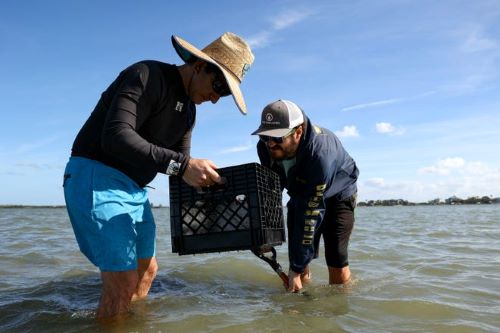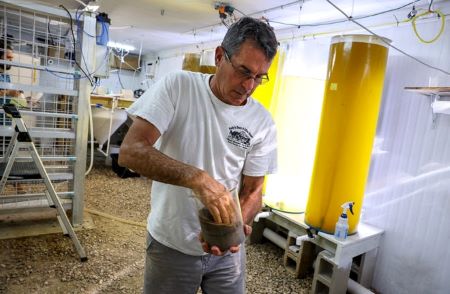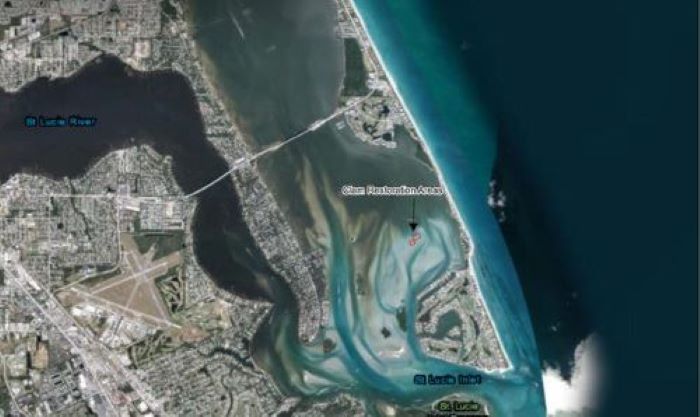by: Timothy O'hara, courtesy of TC Palm
Do lucinid clams hold key to saving Indian River Lagoon? Only if tricky project works
One of the smallest and most hidden creatures in the Indian River Lagoon could be the key to helping struggling seagrass meadows survive and possibly even thrive.
A Treasure Coast project aims to increase the number of lucinid clams that live in the lagoon's seagrass beds in the hope they will remove potentially toxic levels of hydrogen sulfide that kills the plants.
Planting seagrass sprouts in the lagoon is not new, but coupling that with repopulating clams as part of a holistic approach is new. The challenging experiment so far has been filled with both breakthroughs and disappointments.

Can lucinid clams save Indian River Lagoon seagrass?
The plan is to plant millions of clams over a 600-acre area north of the St. Lucie Inlet in Stuart, which historically held dense seagrass meadows and has excellent tidal flushing.
Ultimately, researchers hope to expand the plan to other sections of the lagoon where seagrass growth is stymied by nutrients such as excessive nitrogen and phosphorous from Lake Okeechobee discharges, farmland runoff and leaky septic tanks.
"It's all experimental," said Michael Yustin, a Martin County Public Works environmental project manager. "Each part of the Indian River Lagoon is its own ecosystem, but it's also connected."
Hydrogen sulfide is a natural byproduct of decomposing plant life in low-oxygen conditions, but it can be toxic to seagrass when the seagrass is already stressed by nutrient pollution from other man-made sources, according to Diana Chin, a scientist who conducted research at the Smithsonian Marine Station in Fort Pierce in 2017.

International Seagrass Biology Workshop inspired research
The clams, which burrow into the mud below the surface, contain a bacteria in their guts that remove hydrogen sulfide from the ecosystem.
Chin's research found:
The clams feed on the sulfide from around seagrass roots that can become fatally toxic to the plants when they are stressed by nutrient pollution, low light availability, high water temperatures, extreme salinity variations, and other stressors, Chin said.
When clams were present, seagrass leaves grew slightly faster, regardless of increased shade or sulfide stress.
- When clams were present, underground rhizomes — a plant stem that acts as an organ for both asexual reproduction and food storage — maintained their growth rates. Without clams, they grew more slowly.
- Leaves and rhizomes that grew more slowly tended to be those that had accumulated more sulfur, suggesting toxic sulfide impacted those plants' growth.
- Clams can aid seagrass simply by being present. They could even help seagrass survive and continue growing during periods of intense environmental stress, such as during a harmful algal bloom.
The project, which started three years ago, has experienced some breakthroughs, but the researchers also have suffered setbacks when it comes to rearing the clams.
Chin's presentation at the International Seagrass Biology Workshop in Maryland in 2022 inspired Yustin to embark on the project, along with Great Florida Shellfish Co. owners Tom and Leslie McCrudden. They built and operate a clam hatchery on the lagoon at the Florida Oceanographic Society's Coastal Center in Stuart.
Florida Oceanographic Society and Great Florida Shellfish Co.

The McCruddens and Martin County staff collected clams from St. Lucie River flats in hopes of rearing them, but they all died in the larval stage. In June, they spawned a batch of clams, but they did not live more than a couple of days. Then they tried artificial fertilization, meaning they extracted and combined eggs and sperm from mature oysters.
"I think the timing was wrong. I don't think the eggs were ready to be fertilized," Tom McCrudden said, adding he hoped September and October would prove more successful. "This has never been done before. There is no roadmap. We are looking at other species for ideas."
After tracking clam behavior in the lab and in the wild, the McRuddens created optimal conditions in their tanks and are trying to develop the proper diet. Clams eat algae during different stages of their life, so the lab is filed with lime-, orange- and brown-colored algae growing in clear floor-to-ceiling containers.
"The hardest part has been growing the food," McCrudden said. "If you don't give them good food, you might as well be feeding them cotton candy. There has been a lot of trial and error."

The project shows how various species work together "symbiotically and how to better understand those biological connections," said Florida Oceanographic Society Executive Director Mark Perry. The nonprofit designated two summer interns to work on the project, then created a full-time position for it in August.
"It's really a true research effort," Perry said. "You have an experimental design, control areas and then you do the science. You learn the best techniques. But you have to do the science first."
The $60,000 project, funded by Florida's Indian River Lagoon specialty license plate program, also shows the importance of local research facilities, government agencies and aquaculture companies working together, Perry said
The McCruddens are the largest supplier of clam seed in the state and started the company in their backyard in Delray Beach. Tom McCrudden is a self-taught clam farmer with no formal science education, but years of practical experience. His company earned the Florida Farm Bureau's This Farm CARES designation, given to farmers who use best management practices to protect the environment.
"Tom is an artist and magician," Perry said. "He has the technology. He has the touch. He is the best."
Please consider becoming an AAF member. All text and images in this article appear courtesy of Timothy O'hara and TC Palm- please visit them at https://www.tcpalm.com/ to read more from Tim and many of their other incredible staff.
